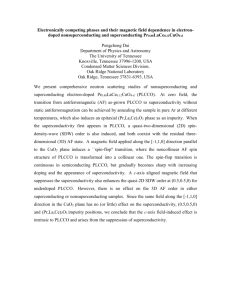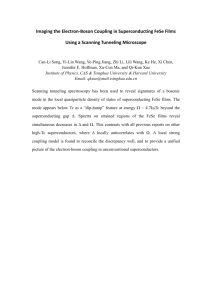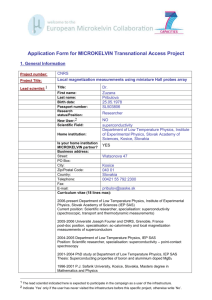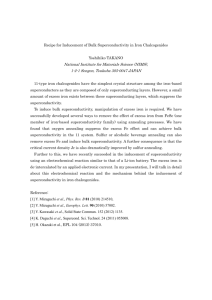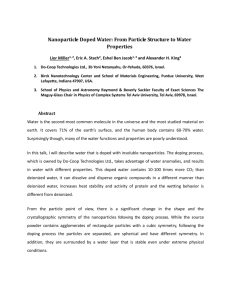Introduction_to_Fe-based_superconductors
advertisement
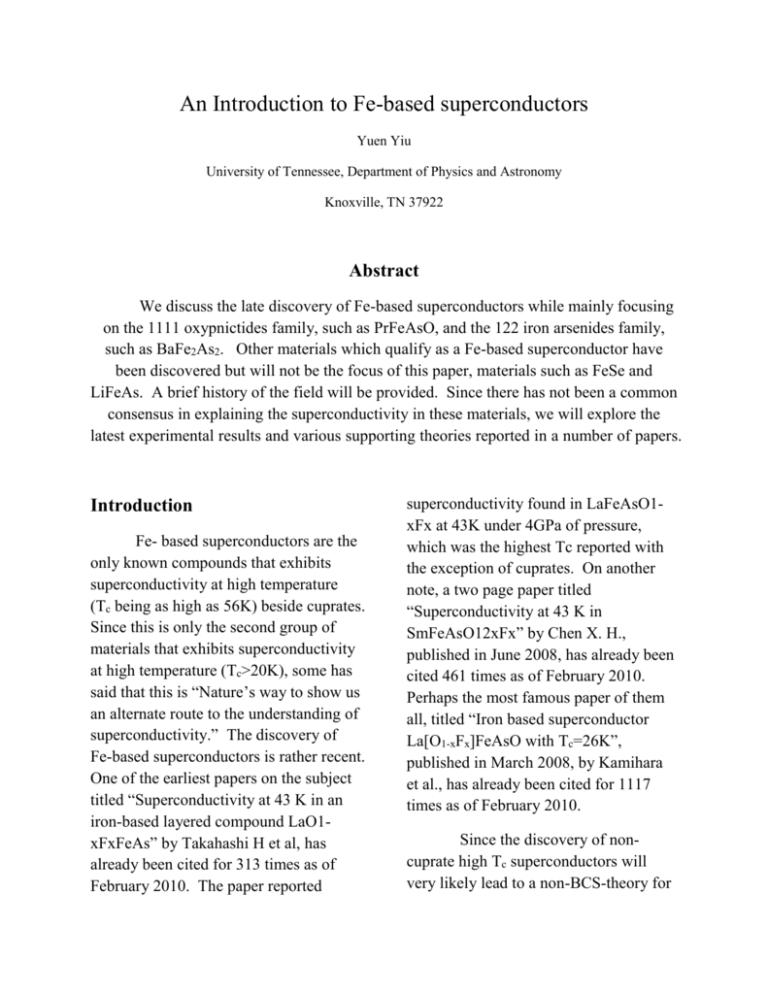
An Introduction to Fe-based superconductors Yuen Yiu University of Tennessee, Department of Physics and Astronomy Knoxville, TN 37922 Abstract We discuss the late discovery of Fe-based superconductors while mainly focusing on the 1111 oxypnictides family, such as PrFeAsO, and the 122 iron arsenides family, such as BaFe2As2. Other materials which qualify as a Fe-based superconductor have been discovered but will not be the focus of this paper, materials such as FeSe and LiFeAs. A brief history of the field will be provided. Since there has not been a common consensus in explaining the superconductivity in these materials, we will explore the latest experimental results and various supporting theories reported in a number of papers. Introduction Fe- based superconductors are the only known compounds that exhibits superconductivity at high temperature (Tc being as high as 56K) beside cuprates. Since this is only the second group of materials that exhibits superconductivity at high temperature (Tc>20K), some has said that this is “Nature’s way to show us an alternate route to the understanding of superconductivity.” The discovery of Fe-based superconductors is rather recent. One of the earliest papers on the subject titled “Superconductivity at 43 K in an iron-based layered compound LaO1xFxFeAs” by Takahashi H et al, has already been cited for 313 times as of February 2010. The paper reported superconductivity found in LaFeAsO1xFx at 43K under 4GPa of pressure, which was the highest Tc reported with the exception of cuprates. On another note, a two page paper titled “Superconductivity at 43 K in SmFeAsO12xFx” by Chen X. H., published in June 2008, has already been cited 461 times as of February 2010. Perhaps the most famous paper of them all, titled “Iron based superconductor La[O1-xFx]FeAsO with Tc=26K”, published in March 2008, by Kamihara et al., has already been cited for 1117 times as of February 2010. Since the discovery of noncuprate high Tc superconductors will very likely lead to a non-BCS-theory for superconductivity, this field is one of the most popular topics among the condensed matter physics community at the moment. In the upcoming APS March meeting in Portland, OR, there will be at least one presentation session (10-15 12 minutes talks) on this topic every single day. Background Some of the parent compounds were known and synthesized since 1995. However the doped, superconducting version of the compounds were not reported until February 2008. F doped LaFeAsO were among the first few which superconductivity reported during the first quarter of 2008. At optimal doping, i.e. LaFeAsO0.89F0.11, the material superconducts at 26K under ambient pressure. As of February 2010, Sr0.5Sm0.5FeAsF is the Fe-based superconductor with the highest Tc at 56K followed by SmFeAsO0.85 from the 1111 family, with Tc=55K. Table 1 Maximum Tc in each FeAs(O1-xFx). The F concentration x, which gives the maximum Tc is shown [10]. The two general formula for the parent compounds, are the 1111 family: LFeAsO, L=La, Sm, Ce, Nd, Pr, Gd, Tb or Dy, and XFe2As2, X=Ca, Ba, Sr or Eu. The Fe-based superconductors generally comprised of conducting layers of Fe-pnitogens (usually As) and L-O in the 1111 family (L= Sm, Nd, Pr, Ce, La), or just X in the 122 family (X= Ca, Ba, Sr or Eu). sandwiched between layers of other substance, except in the “11” family, which only consist of layers of FeSe. Members from these two families generally have relative low maximum Tc compare to those from the “1111” and the “122” families. For example, under optimally Se-deficiency, FeSe superconducts at T=8K. [12] Due to the brevity of this paper, we will be focusing mostly on the more popular and studied “1111” and the “122” families. Figure 1 (a) Crystal structure of LaOFeAs; (b) Crystal structure of (K/Sr)Fe2As2 and (Cs/Sr)Fe2As2 [2] There have been reported on other types of Fe-based superconductors, namely the “111” family and the “11” family. One example from each of the family would be LiFeAs and FeSe. They both have similar structure as the other two families, i.e. layers of FeAs Please pay attention to the fact that the undoped, so called “parent” compounds of the Fe-based superconductors do not superconduct under ambient pressure. For example, in the 1111 family, the parent compound generally undergo a tetragonalorthorhombic structural phase transition upon cooling, following a magnetic phase transition at a lower temperature. Both the phase transition described above do not exist in their doped, superconducting counterparts. This behavior is very similar to the undoped cuprate superconductors. Figure 2 The structural, magnetic, and superconducting phase diagram of PrFeAsO1−xFx, 0<x<0.225 as determined from synchrotron x-ray powder-diffraction, magnetization, and resistivity measurements [3]. There are a lot of opportunity to perform research in this field everywhere, including institutes such as the University of Tennessee and the Oak Ridge National Laboratory. Synthesis of material Polycrytalline samples of the compound can be synthesized by conventional solid state reaction. For example, synthesis of PrFeAsO, made from PrAs, Fe2O3 and Fe powders. Stoichiometric mixtures were ground and mixed in glovebox, pressed into pellets, sealed in silica tubes in argon, and then heated at 1200C for 30 hours. The rest of the members from 1111 can be made using somewhat similar methods, for example, single phase samples of CeFeAsO were made from CeAs, Fe2O3 and Fe powders [4]. The samples are then stored in an argon filled glovebox, even though the compound’s sensitivity to oxygen under ambient temperature and pressure has not been reported. Polycrystalline samples of the 122 family can also be synthesized in a similar fashion, i.e. stoichiometric amounts of the starting materials were mixed and pressed into pellets, sealed in quartz containers then heated up to T>100oC for an extended amount of time [2]. The doped superconducting counterparts can be made by simply adding the correct amount of doping agent into the starting mix [4]. Experimental studies Various measurements have been performed on these materials, including but not limited to, electrical resistivity, magnetic susceptibility, specific heat, neutron scattering and X-ray diffraction, on both the undoped and the doped compounds. electron doping at Fe-sites with Ir [6] or Co [7], with Tc>20K. Figure 3 A typical resistivity diagram of a Febased superconductor at different doping levels. Showing is the temperature dependence of electrical resistivity of LaFeAsO1-xFx. The inset is a phase diagram constructed with the data. [9] Above is a resistivity measurement done on LaFeAsO1-xFx on different doping levels. The broad peak around T=150K for x=0.0 is suppressed and shifted to a lower temperature as doping increases, eventually inducing superconductivity at x=0.06 with Tc=17K. The broad peaks seen in the undoped and underdoped compounds can be generally associated with the spin density wave phase of the material. It is believed that superconductivity can be induced by suppression of the spin density wave with chemical doping or applied pressure [11] Even though most of the reported superconducting 1111’s are oxygen deficient versions of the parent compound, there have been reports on superconducting state being induced by Figure 4 The structural, magnetic, and superconducting phase diagram of BaFe2xCoxAs2 a member from the 122 family [13] Above is a typical phase diagram constructed with data from various experiments. This is rather puzzling since according to the phase diagram, there is a region where the superconducting ground state overlaps with static magnetic state. The superconductivity in the 122 family can be induced by doping on either the Fesite or the A-site (i.e. AFe2As2) [10]. one should be able to “tuck” the layers of apple further into the lower later. However, this phenomenon was also observed in Co doped samples. Unlike Ru or Ir, Co has a slightly smaller radius than Fe, but the shrinking of c-axis versus doping is comparable with those with Ru or Ir doping. Figure 4 Doping dependence of the c-axis lattice constant (top panel) and a-axis lattice constant (bottom panel) of SrFe2-xMxAs2. It shows a common feature that the a-axis lattice constant expands, while the c-axis one shrinks monotonically with Rh, Ir, and Pd substitution. [8] The doping dependence of the caxis lattice, which decreases as the amount of doping increases, is reported in most of the systems, including both the 1111 and 122 families. It was proposed that this is due to the substitution of Fe atoms for those with larger radius would increases lattice parameter a and b, while decreases parameter c. Imagine having a network of closely packed oranges on one surface, with another layer of apples on top, by replacing the oranges with watermelons, Figure 4 Observed (crosses) and calculated (solid line) neutron diffraction intensities of PrFeAsO at 175 K and 5K The 175K data was fitted with tetragonal structure with space group P4/nmm, while the 5K data was fitted with orthorhombic Cmma. The inset on the left shows the detailed data for 18°<2θ<38°, where most of the observable magnetic peaks are located. Magnetic peaks can be seen in the 5K data but not at 175K. The inset on the right shows the splitting of the 220 peak in the tetragonal structure, indicating a structural phase transition between the two temperatures [5]. Theories Conclusion From an experimentalist point of view, it seems that the superconducting ground state can be induced by suppressing the magnetic phase transition, which can be done in a various ways such as F-doping of oxygen or simply by creating oxygen deficiency [5]. This is however not always the case [11]. The field of Fe-based superconductors is new and exciting. There are new theories proposed for the systems every month and new discoveries that contradicts the theories the month after. The Fe-based superconductors have many things that resemble their cuprates counterparts, but it is also obvious that the existing BCS theory is not sufficient to explain the phenomenon. This however should be perceived as an obstacle but rather a new rung on the ladder that will hopefully lead us to further understand the mechanism behind high temperature superconductivity. For those that superconducts after the structural and magnetic transitions are suppressed, there have been various proposed theories for the behavior. Here we will very briefly introduce one of the many theories proposed. One group suggested the s±pairing state, arguing that superconductivity in Fe-based superconductors is unconventional and mediated by anti-ferromagnetic spin fluctuations. The theory suggested that the superconductivity is induced by the nesting-related anti-ferromagnetic spin fluctuations near the wave vectors connecting the electron and hole pockets. [10, 14] There is no common consensus among the scientific community on any particular theory/ model for Fe-based superconductors yet. _________ [1] Liu R. H. et al, Phy. Review Letters, 101, 087001 (2008) [2] Sasmal K. et al, Phy. Review Letters, 101, 107007 (2008) [3] Rotundu C. R. et al, Phy. Review B, 80, 144517 (2009) [4] Ren Z. A, Materials Research Innovations 12, 1 (2008) [5] Zhao J. et al, Phy. Review B, 78, 132504 (2008) [6] Qi Y. P. et al, Phy. Review B, 80, 054502 (2009) [7] Wang et al, Phy, Review B, 78, 054521 (2009) [8] Han F. et al, Phy, Review B, 80 024506 (2009) [9] Dong J. et al, Europhys. Letter, 83, 27006 (2008) [10] Ishida k. et al, Journal of the Phy. Socity of Japan, 78, 062001 (2009) [11] McGuire M. A. et al, Journal of Solid State Chemistry, 182, 8, p 2326-2331 (2009) [12] Hsu F. C. et al., Proc. Natl. Acad. Sci. U.S.A. 105, 14262 (2008) [13] Wang X. F. et al., arXiv:0811.2920. [14] Mazin I. I. et al., Phys. Rev. Lett., 101 057003 (2008)



